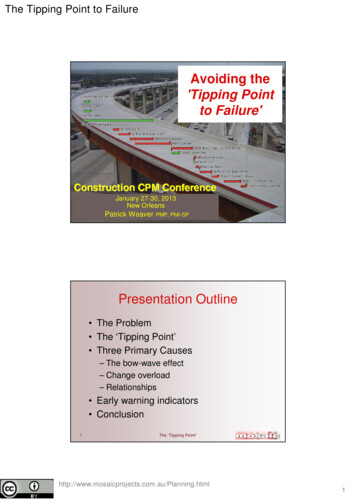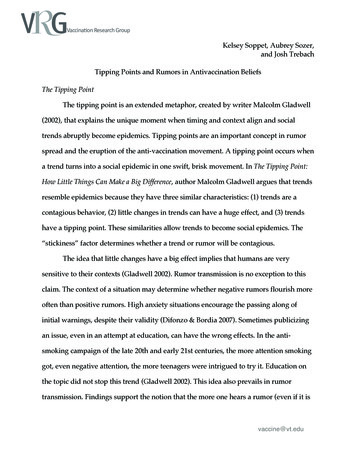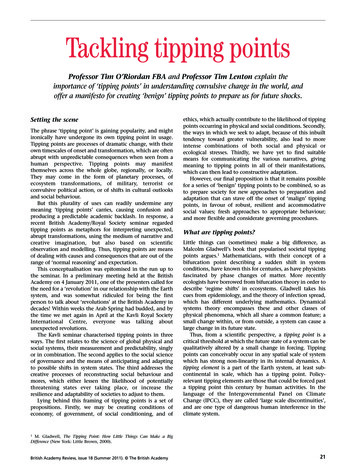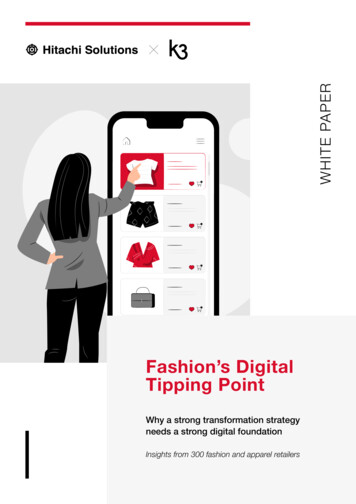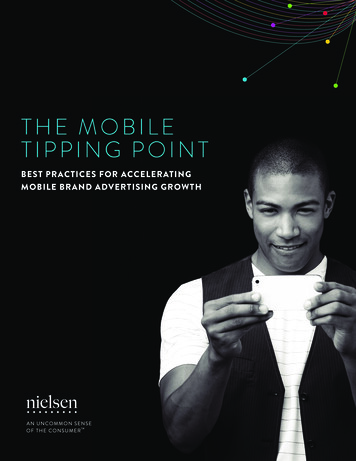
Transcription
THE MOBILETIPPING POINTBEST PRACTICES FOR ACCELERATINGMOBILE BRAND ADVERTISING GROWTHCopyright 2014 The Nielsen Company1
CONTENTSExecutive Summary. 3Following Consumers’ Lead: Current MobileBrand Advertising Practices. 5Mobile Ad Formats, Channels, and Platforms.9Challenges for Mobile Advertisers. 12Relevant Metrics Could Accelerate Growth. 14Additional Mobile Brand Advertising Best Practices. 19Conclusion. 26Methodology. 272THE MOBILE TIPPING POINT
EXECUTIVESUMMARYThe new mobile medium represents an appealing opportunity for brandmarketers - enabling them to reach a pool of consumers that are growing bythe day anytime and anywhere. Because of its relative youth, however, thereis still confusion over how best to engage in mobile advertising. Differencesin technology mean that marketers cannot always employ the same bestpractices in mobile that are used for television or online advertising.Unlike the online medium, mobile is being adopted for branding purposesrelatively early. However, mobile marketers and media owners identified theinability to measure the effectiveness of their mobile efforts consistentlywith other media as one of their biggest pain points, and a significantbarrier to mobile growth.Through interviews with advertisers, agencies, and media providers, thispaper provides insights on current mobile advertising activity, the mobileadvertising outlook for the coming year, and best practices emerging formeasuring and optimizing mobile advertising.Highlights from this report include Spending on mobile brand initiatives will grow faster than spending ondirect response initiatives in 2014. One-fifth (21%) of advertisers willincrease their mobile brand spend by more than 20 percent in 2014.Roughly three-quarters of new mobile funds will come at the expenseof other online and offline budgets. Advertisers are increasingly using mobile advertising as an integrated,cross-platform tactic, and are running it in conjunction with otheronline (90%) and offline media (80%). Accordingly, marketers would “prefer to use the exact same metricsused in the offline medium, and additional metrics specific to themobile medium” to measure their mobile campaigns (39%). Advertisers most desire GRPs to measure audience reach (37%) andbrand lift to measure ROI (53%). Publishers, however, mainly report adserver impressions (78%) and clickthrough rates (74%). As a result of this misalignment, many advertisers (55%) are doubtfulor unconvinced of publishers’ targeting claims and about mobileadvertising’s effectiveness, indicating that the medium’s potentialgrowth may be hampered by a lack of relevant metrics that are widelyadopted and used.Copyright 2014 The Nielsen Company3
In addition to relevant metrics, there are other best practices that, ifadopted, brands and agencies said would increase their use of mobilebrand advertising, including: Alignment on and communication of campaign goals before thecampaign start (68%) Monitoring campaigns for in-flight improvement opportunities (68%) Calculating the ROI of every campaign (77%) Measuring reach and ROI at the same time (70%)Media sellers and agencies that adopt these best practices and invest in whatis needed to deliver these capabilities will be in the best position to captureresulting growth in mobile brand spending.4THE MOBILE TIPPING POINT
FOLLOWINGCONSUMERS’LEADMobile devices have come a long way since their heavy, bricklike predecessors were first introduced in 1983. These devicesare now much more than on-the-go telephones, morphing andgrowing into a companion that is always on and always with us.Smartphones now make up 70 percent of all mobile phones inthe U.S., up from 18 percent just four years ago1. We now spendso much time on our phones (34 hours monthly) that it hassurpassed time spent on our computers (27 hours monthly)2.Brand marketers are starting to experiment with mobile in theiradvertising campaigns to stay in front of consumers. Eightyeight percent of the advertisers and 90 percent of the agencieswe surveyed told us they had bought some form of mobileadvertising in the past 12 months.When compared with online and TV, mobile advertising isa young medium and still relatively new to most marketers.The majority of advertisers surveyed (82%) had three yearsor less experience with mobile, with 21 percent “just gettingstarted.” Agencies were in a similar position, with 70 percent ofrespondents having three years or less experience with mobile.This lack of experience is reflected in the fact that a large groupof agencies and advertisers indicated that less than 1 in 10 oftheir 2013 campaigns included a mobile component. However,an equally sizable portion of respondents – obviously earlyadopters – indicated more than half of their campaigns includeda mobile component (Fig 1).FIG 1. PERCENTAGE OF 2013CAMPAIGNS INCLUDING AMOBILE 1%0%41-50%5%8%51% 18%AGENCIES1Source: Nielsen US Mobile Device Insights Q1 20142Source: Nielsen Digital Consumer Report Q1 2014Copyright 2014 The Nielsen Company34%BRANDS5
When it comes to budget, almost half of the advertisers surveyed saidthat they allocated less then 10 percent of their 2013 digital advertisingbudget to mobile advertising (Fig 2), indicating most advertisers are stilltesting the mobile waters. A small vanguard of advertisers committedmore substantial amounts of budget to mobile, with 3 in 10 advertiserssurveyed indicating that they allocated more than 20 percent of their2013 budgets to mobile advertising.FIG 2. ADVERTISERS: 2013 DIGITAL BUDGETS DEDICATED TO MOBILE46%23%1-10% OFBUDGET31%11-20% OFBUDGET21% OFBUDGETMOBILE GROWSAS BRANDINGMEDIUMAsked, “What is the primary purpose of your mobile advertisingcampaigns?” nearly half of all advertisers replied, “branding,” withobjectives such as driving awareness or influencing brand opinions.Unlike online advertising, which for decades remained the domain ofdirect response advertisers before it started being used as a brandingplatform, mobile has attracted brand advertisers relatively early on.6THE MOBILE TIPPING POINT
Given how quickly the mobile device has become a part of our everydaylives, brand marketers are keen to understand how they can use thismedium to connect with their desired audiences and influence theirbrand opinions. As a result, advertisers indicate that mobile spendingon branding-related objectives will grow faster than direct response (Fig3). More than 1 in five advertisers say their 2014 mobile brand spendingwill grow by more than 20 percent. None of the advertisers surveyedindicated they would be decreasing their mobile advertising spend inthe coming year.FIG 3. ADVERTISERS’ OUTLOOK FOR 2014 MOBILE ADVERTISING BUDGETSBRANDING23%77%DIRECT RESPONSE32%STAY THE SAMECopyright 2014 The Nielsen Company68%GROW7
Where are the dollars coming from to fund these mobile brandingcampaigns? Only 27 percent of marketers surveyed say that “mobile hasits own dedicated budget” (Fig 4), indicating that there is enough focusand attention on mobile advertising within those organizations to meritearmarking dollars specifically for that purpose. Most of the advertiserswe surveyed say their mobile advertising spend would be increasingat the expense of other media, underscoring advertisers’ experimentalapproach to mobile.FIG 4. ADVERTISERS: WHERE DOLL ARS FOR MOBILEADVERTISING ARE COMING FROM51%46%27%FROM ONLINECHANNELSSOCIAL -0%VIDEO -8%DISPLAY -27%FROM OFFLINECHANNELSNONE, MOBILEHAS ITS OWNDEDICATEDBUDGETOTHER ONLINE - 16%8THE MOBILE TIPPING POINT
A D F O R M AT S ,CHANNELS, ANDP L AT F O R M SFIG 5. MOBILE MEDIUMSADVERTISERS HAVE USED ORPLAN TO USEWhen it comes to where marketers are advertising, advertisers andagencies are more or less evenly splitting their attention betweenadvertising on the mobile web and in mobile apps across smartphonesand tablets (Fig. 5). Three-quarters of marketers also indicate thatthey use mobile ad networks, showing that the most popular wayto advertise on mobile is through a third party to quickly and easilyachieve reach.MOBILE APPS50%59%MOBILE WEBWhen it comes to mobile ad formats, advertisers and agencies aresticking to the tried and true tactics from their online campaigns forboth tablet and smartphone platforms. Mobile display and video, forexample, are the two leading choices for both mobile web and mobilein-app advertising (Fig 6). Mobile-specific features such as mobile textadvertising and click-to-call are still relatively new to marketers andthus used lightly.63%64%TABLETSSMARTPHONESFIG 6. MOBILE FORMATS ADVERTISERS HAVE USED OR PL AN TO USE71%77%59%14%MOBILEDISPLAY27%MOBILE pyright 2014 The Nielsen Company56%63%MOBILERICH RTPHONES9
The majority of brands and agencies plan to allocate their advertisingto iOS and Android tablets and smartphones (Fig 7, Fig 8). Thesetwo platforms have the highest market share among consumers – acombined 93 percent of smartphone owners and 80 percent of tabletowners3.FIG 7. TABLET ADVERTISING VS. CONSUMER MARKET T - MARKETER USAGE15% 1%3%BLACKBERRY10%OTHERTABLET - CONSUMER USAGEFIG 8. SMARTPHONE ADVERTISING VS. CONSUMER MARKET SHARE97%94%58%35%APPLE/IOS4%ANDROIDSMARTPHONE - MARKETER USAGE31041%WINDOWS20% 2%BLACKBERRY3% 0%OTHERSMARTPHONE - CONSUMER USAGESource: Nielsen Mobile Device Insights, U.S., Q2, 2013THE MOBILE TIPPING POINT
Marketers are deploying mobile campaigns not just on their own, butalso as a complement to other media. Most mobile advertising is runin conjunction with other online and offline advertising. Only a smallpercentage of respondents said they rarely or never run mobile withanything else, indicating a low incidence of mobile-only campaigns.FIG 9. ADVERTISERS: HOW OFTEN MOBILE ADVERTISING ISRUN IN CONJUNCTION WITH OTHER TACTICS72% 18% 10%BRAND - ONLINE75%AGENCY - ONLINEBRAND - OFFLINE51%AGENCY - OFFLINE52%MOST OR ALL OF THE TIMEHALF OF THE TIME OR LESS21% 4%36% 13%28%20%RARELY OR NEVERFor brand advertisers, the preferred online advertising pairings withmobile are display (90%), social (67%) and video (59%). Agencies mostoften pair mobile with display (83%), video (75%) and rich media (70%).Among offline media, brands prefer to run mobile ads alongside TV(41%), radio (31%) and print (28%), while agencies most often use print(50%), TV (45%) and radio (43%).This shows that mobile advertising is often viewed as an integrated partof the marketer’s toolkit, and runs as part of multi-platform campaigns.Mobile is not a medium in a vacuum, but one of many tactics thatmarketers use to influence branding-focused objectives.Copyright 2014 The Nielsen Company11
CHALLENGESFOR MOBILEADVERTISERSIronically, it’s this pairing of mobile with other mediums and focus onbranding that gives rise to advertisers’ biggest mobile pain points.Advertisers say their two biggest obstacles to further mobile growthare calculating mobile return on investment (ROI) and lack of relevantsuccess metrics for their mobile campaigns (Fig 10).FIG 10. ADVERTISERS’ TOP MOBILE BRAND ADVERTISING PAIN POINTSCALCULATINGMOBILE ROIRELEVANT SUCCESSMETRICS56%46%When asked what type of metrics advertisers would like to use, the mostcommon response (given by 39%) is “the exact same metrics as offline,and additional metrics specific to the mobile medium” to ensure they aremeasuring and optimizing mobile activity consistently with their otherinitiatives (Fig 11).12THE MOBILE TIPPING POINT
Since marketers are running mobile increasingly with both online andoffline tactics, it is not surprising that they also seek metrics that canspan both platforms. The increasing focus on brand objectives makesthis especially true, as relevant brand metrics are much more commonin the offline medium than the digital medium. However, advertisersalso recognize there is a unique aspect of the mobile medium that doesnot exist offline that they can use to their advantage – for example, theopportunity to granularly measure audience reach or to validate theeffectiveness of the campaign directly against the campaign audience.Only 23 percent responded that they’d like to “primarily rely on metricsspecific to the mobile medium,” indicative of the low incidence ofmobile-only campaigns.Unfortunately only 22 percent of media sellers can provide the offlineand mobile metrics that advertisers are looking for. There is clearly adisconnect in the metrics desired by advertisers and provided by mediasellers, opening up a huge opportunity for media sellers who are ablebridge this gap.FIG 11. METRICS ADVERTISERS WOULD LIKE TOUSE VS. METRICS PUBLISHERS PROVIDE13%25%WE WOULD PREFER TO USE THE EXACTSAME METRICS, AND NOTHING ELSE39%22%WE WOULD PREFER TO USE THE EXACTSAME METRICS, AND ADDITIONAL METRICSSPECIFIC TO THE MOBILE MEDIUMWE WOULD PREFER TO USE SOME OFTHE SAME METRICS FROM THE OFFLINEMEDIUM, AND SOME METRICS SPECIFICTO THE MOBILE MEDIUM26%22%23%30%WE WOULD PREFER TO RELYPRIMARILY ON METRICS SPECIFICTO THE MOBILE MEDIUMADVERTISERSCopyright 2014 The Nielsen CompanyMEDIA SELLERS13
R E L E VA N TMETRICS COULDA C C E L E R AT EGROWTHAddressing this disconnect could pay large dividends: 30 percent ofadvertisers and 37 percent of agencies say that the “ability to use thesame metrics to evaluate audience reach on mobile as are used offline”would lead them to increase their use of mobile advertising.As a best practice, media sellers should offer the relevant metricsadvertisers are looking for. According to advertisers, the mostappropriate metric to measure a mobile brand advertising campaign’sreach is gross rating points (GRP) (Fig 12). GRPs have long been thestandard metric used to demonstrate audience reach in the TV medium,which further illustrates advertiser desire for offline metrics for themobile medium. However, media sellers most often report the campaignimpressions from the ad server, which primarily measures what wasdelivered as opposed to the audience it was delivered to.The confusion over metrics is even more pronounced when it comes tomeasuring mobile ROI. Publishers most often measure the ROI of mobilebrand advertising campaigns using clickthrough rates (Fig 12). Whenasked which is the most appropriate metric for measuring mobile brandadvertising ROI, advertisers and agencies both respond the number onemetric is brand lift. Publishers are able to offer a mobile-only measureof what was delivered, while agencies and advertisers are looking for anoffline-equivalent metric for campaign effectiveness.14GRP: STANDS FOR GROSSRATING POINTS, WHICH ISTHE PERCENTAGE OF THEAUDIENCE REACHED BYAN AD MULTIPLIED BY THEFREQUENCY WITH WHICHTHEY SEE IT IN A GIVENCAMPAIGN. THIS METRIC ISUSED TO MEASURE THE SIZEOF AN AUDIENCE REACHEDBY AN AD OR PROGRAM.BRAND LIFT: THEPERCENTAGE INCREASE INTHE PRIMARY MARKETINGOBJECTIVE OF A BRANDADVERTISING CAMPAIGN,MOST OFTEN DEFINED INTERMS OF THE CLASSICPURCHASE FUNNEL – LIFTIN AWARENESS, ATTITUDES,FAVORABILITY, PURCHASEINTENT, OR PREFERENCE.THE MOBILE TIPPING POINT
FIG 12. ADVERTISERS’ MOST APPROPRIATE METRIC VS.METRIC PUBLISHERS REPORT MOST OFTENADVERTISERS: MOSTAPPROPRIATE METRICREACHRESONANCECopyright 2014 The Nielsen CompanyPUBLISHERS: WHAT IREPORT MOST OFTENGROSSRATINGPOINTS (GRP)AD SERVERIMPRESSIONSBRAND LIFTCLICKTHROUGHRATE15
This absence of relevant reach metrics leaves both brand advertisers andagencies in serious doubt of mobile networks and publishers’ audienceclaims. Only three percent of advertisers and six percent of agencies“strongly believe” claims to be able to reach a specific mobile audience(Fig 13). The majority of advertisers (55%) and agencies (54%) surveyedare uncertain or outright disbelieve audience reach claims, potentiallyhampering future growth of the medium. Media sellers’ verificationof such claims with the right metrics could go a long way in easingconcerns and capturing mobile spend. Sixty percent of advertisers and69 percent of agencies said that the “ability to verify that my mobileadvertising was actually delivered to the intended audience” would leadthem to increase their use of mobile advertising.FIG 13. MEDIA BUYER VIEWS OF MOBILE AUDIENCE REACH CL E3%STRONGLYDISBELIEVETHE MOBILE TIPPING POINT
The confusion over appropriate ROI metrics has a significant impact onadvertiser attitudes towards mobile brand advertising effectiveness.More than half of brand advertisers think that mobile “moves the needlewhen combined with other efforts, but I’m not sure how to measurereach or ROI” (Fig 14), while three percent of advertisers flat out said“I don’t think [mobile] works.”FIG 14. ADVERTISER VIEWS ON MOBILE BRAND ADVERTISING EFFECTIVENESS52%29%I think it moves the needle whencombined with other efforts, butI’m not sure how to measure reachor ROIIt’s a promising new tactic, butit’s effectiveness in reachingmy audience and achieving mybranding-related objective is16%3%It effectively reaches my audienceand produces a measurable ROI formy branding-related objective (withROI defined as metric achieved perdollar spent)Copyright 2014 The Nielsen CompanyI don’t think it works17
There is a great opportunity to dispel a lot of this confusion and growthe mobile medium by all parties involved with a campaign—advertiser,agency and media plan participants—using relevant brand lift metricsto calculate mobile ROI. Reflecting that this is their biggest mobilepain point, 62 percent of advertisers and 57 percent of agencies saythe “ability to verify that brand advertising created the desired result(e.g. increased brand awareness)” will lead them to increase their useof mobile advertising (Fig 15). Media sellers need to provide the metricadvertisers are looking for – brand lift. Those who do will have the upperhand in capturing dollars from those advertisers on the fence aboutwhether mobile ads achieve their desired end.FIG 15. ABILITY TO VERIFY THAT BRAND ADVERTISING CREATED THE DESIREDRESULT WILL LEAD TO INCREASED MOBILE ADVERTISING USEADVERTISERS62%18AGENCIES57%THE MOBILE TIPPING POINT
OTHER MOBILEBRAND ADVERTISINGBEST PRACTICESIn addition to addressing the confusion over mobile metrics, this studyalso identified other gaps between the expectations of brand marketersand their partners in the mobile media ecosystem, and resulting bestpractices. If these best practices are employed, it could materiallyimprove the mobile brand advertising outlook.THE NEED: CAMPAIGN GOALCOMMUNICATIONThere is a clear opportunity for increased collaboration between mobilemedia buyers and sellers. Nearly all advertisers said that defining thecampaign’s audience and advertising objective, and establishing anappropriate success metric among everyone involved in the campaignbefore the campaign starts were “very important” or “somewhatimportant” for a successful mobile campaign (Fig 16). However,the media sellers surveyed indicated that these communicationswere actually happening less than half of the time, illustrating a bigdisconnect between what should be happening versus what is actuallyhappening.Copyright 2014 The Nielsen Company19
BEST PRACTICE: ALIGN ALL CAMPAIGNMEMBERS ON CAMPAIGN GOALSIt is critical that everyone involved with a campaign be on the samepage regarding campaign goals: the intended campaign audience, theprimary marketing objective and the metrics for success. Agencies andpublishers must spearhead these conversations with brand marketersto clearly establish campaign goals and appropriate success metricsbefore the campaign starts. Brand marketers must also take on theresponsibility of proactively and clearly defining the primary audiencesand goals for their mobile campaigns.In our opinion, the easiest way to accomplish this is to invest in systemsthat allow everyone involved in the campaign to view and directlycollaborate around the campaign’s performance against the desiredaudience and primary marketing objective. In the best possible world,everyone would log into the same system to monitor, evaluate andoptimize the mobile advertising investment. These systems would helpincrease campaign performance and ROI, and the ability to offer suchcollaboration likely would attract more brand dollars.FIG 16. WHAT ADVERTISERS SAY IS IMPORTANT FOR A SUCCESSFUL CAMPAIGN VS.WHAT PUBLISHERS SAY ACTUALLY HAPPENS FOR EVERY CAMPAIGNDEFINE CAMPAIGN'S TARGET AUDIENCE (E.G. AGEAND GENDER) BEFORE CAMPAIGN STARTDEFINE CAMPAIGN’S PRIMARY ADVERTISINGOBJECTIVE BEFORE CAMPAIGN STARTESTABLISH METRIC THAT WILL BE USED TOMEASURE SUCCESS BEFORE CAMPAIGN STARTCOMMUNICATE AUDIENCE AND OBJECTIVE TO ALLCAMPAIGN MEMBERS BEFORE CAMPAIGN RSTHE MOBILE TIPPING POINT
THE NEED: IN-FLIGHT IMPROVEMENTSThe vast majority (84%) of advertisers rank “monitoring campaigns for inflight improvements” as important for a successful mobile campaign; 68percent say it is very important (Fig 17). Agencies echoed this sentiment,with 76 percent saying “collaborating with media plan participants for inflight optimization” is important for a successful campaign. This indicatesthat not only is optimization important, agencies expect media partnerinvolvement in the process. However, only a small fraction of publishersare regularly optimizing on the metrics that advertisers and agencieshave deemed appropriate.BEST PRACTICE: OPTIMIZE PERFORMANCEIN-FLIGHT USING REAL-TIME DATAReal-time metrics are essential to optimizing brand campaigns while theyare in market. Regular measurement and optimization by agencies andmedia sellers will help ensure that campaigns are consistently reachingand resonating with the right audience, thereby maximizing mobileadvertising ROI. Armed with the necessary real-time data and processfor consistent success, media sellers can use this to confidently offer andfulfill guarantees for audience delivery or brand performance. Roughlyone-third of advertisers say audience and brand performance guaranteeswould lead them to increase their use of mobile advertising. In order tomake in-flight improvements, whether to increase performance or tomeet guarantees, brand marketers, agencies and media sellers all needto ensure they are getting the right metrics in real-time. Post-campaignreports are not enough for this fast-paced medium.Copyright 2014 The Nielsen Company21
FIG 17. ADVERTISER VS. PUBLISHER OPTIMIZATION ATTITUDES AND PRACTICES84%76%11%4%BRANDS: MONITORINGCAMPAIGNS FOR IN-FLIGHTIMPROVEMENTS IS IMPORTANTPUBLISHERS: ACTUALLY OPTIMIZEMOST CAMPAIGNS AGAINST AGEAND GENDER WHILE IN-FLIGHT22AGENCIES: COLLABORATING WITH MEDIA PLANPARTICIPANTS TO OPTIMIZE PERFORMANCEDURING CAMPAIGN IS IMPORTANTPUBLISHERS: ACTUALLY OPTIMIZE MOSTCAMPAIGNS AGAINST BRAND LIFT WHILEIN-FLIGHTTHE MOBILE TIPPING POINT
THE NEED: REACH AND ROI MEASUREMENTSeventy percent of advertisers and 47 percent of agencies say the “abilityto measure audience and ROI at the same time” would increase their useof mobile advertising, while half of publishers say it would increase theirmobile sales (Fig 18). Using the same system to obtain this informationcould save time and reduce errors due to implementation complexity.Unfortunately, very few companies measure the two. Ten percent ofagencies and 11 percent of publishers say that no one monitors thereach or ROI of their mobile brand advertising campaigns.BEST PRACTICE: MEASURE REACH AND ROIAT THE SAME TIMEThe recipe for marketing effectiveness is relatively simple, and the sameacross all screens. For a campaign to be effective, marketers must reachthe right person and influence their opinion. Reach and ROI informationis critical for improving advertising effectiveness. Marketers, agencies,and publishers should adopt solutions, ideally a single platform using asingle tag, that allows them to easily evaluate campaign reach and ROIusing relevant GRP and brand lift metrics.FIG 18. MEASURING REACH AND ROI AT THE SAME TIME70%50%10%10%Brands: Ability to measureaudience reach and ROI at thesame time would increase myuse of mobile advertisingAgencies: No onemeasures reachCopyright 2014 The Nielsen CompanyPublishers: Ability to measureaudience reach and ROI at thesame time would increase salesAgencies: No onemeasures ROI23
THE NEED: ROI CALCUL ATIONNearly all (97%) of advertisers say it is important to calculate ROI at theend of every campaign, and brands rank brand lift as the most appropriatemetric with which to calculate ROI (Fig 19). Unfortunately, only one-thirdof agencies and publishers are actually calculating ROI at the end of everycampaign. This is not surprising given the metrics that publishers use tocalculate ROI are oftentimes more suited to direct response objectives andare not the brand lift metrics that advertisers and agencies are looking for.This may also explain why more than half of brand advertisers think thatmobile “moves the needle when combined with other efforts, but I’m notsure how to measure reach or ROI.”BEST PRACTICE: USE RELEVANT METRICS TOCALCUL ATE ROI FOR EVERY CAMPAIGNBrand relevant metrics are key to accurately assessing performance andclarifying actual ROI for branding-related campaigns. Other metrics arerelevant only in that they positively correlate with brand lift, but do notdirectly measure brand performance. Direct response metrics, such asclickthrough rates, are not relevant for assessing brand performance, andmay be misleading.Fortunately, the tools for measuring brand lift already exist and can beeasily deployed for every mobile brand advertising campaign. This allowsagencies and publishers to calculate ROI using relevant metrics at theend of every campaign and prove their ability to execute effective mobilebrand advertising campaigns.FIG 19. ADVERTISER ATTITUDES TO ROI CALCUL ATION VS. ACTUAL PRACTICE97%2470%Brands: Calculating ROI at endof campaign is importantBrands: Improved clarity around actualreturn on brand advertising investmentwill increase my use of mobile advertising35%32%Agencies: Actually calculateROI at end of every campaignPublishers: Actually calculateROI at end of every campaignTHE MOBILE TIPPING POINT
THE NEED: PERFORMANCE CONTEXTIn addition to clarity around how the campaign is performing, marketerswould also like context for their ad performance as compared withthe rest of the industry. Over one-third of all brands, agencies andpublishers said one of their biggest mobile pain points is a lack ofmobile benchmarks (Fig 20).Currently, advertisers receive benchmarks from a variety of sources,ranging from internal benchmarks they keep themselves to benchmarksfrom their agencies, vendors and industry organizations. However,10 percent of advertisers say they have no benchmarks for reach, and13 percent say they have no benchmarks with which to evaluate ROI;leaving them in the dark as to what their performance means and howthey compare to their peers.BEST PRACTICE: DEVELOP MOBILEBENCHMARKSConsistent measurement of every campaign is key to building internalmobile benchmarks. When evaluating partners to work with, ormeasurement tools to adopt, media sellers and buyers should look forthe ability to compare their campaign to industry norms or, even better,to internal, client-specific benchmarks that they maintain.FIG 20. IDENTIFIED L ACK OF MOBILE BENCHMARKS ASBIGGEST MOBILE PAIN POINT31%BRANDSCopyright 2014 The Nielsen Company33%AGENCIES35%PUBLISHERS25
CONCLUSIONThe responses to this survey point to enthusiasm for the mobile space,but that enthusiasm is tempered by large gaps in how to appropriatelyshow the effectiveness of the mobile medium. As mobile marketingmatures, the need for relevant mobile metrics will only become moreurgent.Marketers are using mobile as an integrated tool alongside other tacticsand mediums to achieve branding-related objectives. Agencies andmedia sellers need to ensure that they are offering metrics that are alsobrand-focused and can span multiple platforms. These metrics needto be offered consistently on every relevant campaign, and everyoneinvolved with a campaign—advertiser, agency, and media planparticipants—must be on the same page. In addition, they must be ableto collaborate on improving campaign performance using these metrics.Only then will the mobile medium rise out of the metrics morass it iscurrently in.There are many other best practices that advertisers, agencies andmedia sellers can adopt to better work together to increase theeffectiveness of the mobile marketing experience. This includesimproving communication and collaboration amongst all membersassociated with a campaign, ensuring that the right reach and ROIinformation is captured, and taking action on data while the campaignis still in-market to improve performance. These actions will go a longway in addressing the current mobile pain points.We have reached a tipping point in mobile brand advertising. The toolsand solutions that can help address the confusion with mobile metricsare being developed or already exist. As mobile advertising grows,advertisers, agencies and media providers need to coalesce aroundthese tools and solutions and start to work around a common currencyof communication. By doing so, mobile marketers will begin to addressthe challenges highlighted in this study and help grow the medium toits full potential.26
THE MOBILE TIPPING POINT Copyright 2014 The Nielsen Company 5 FOLLOWING CONSUMERS' LEAD Mobile devices have come a long way since their heavy, brick-


